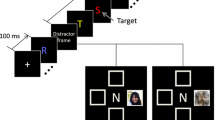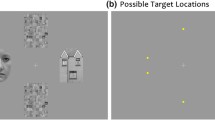Abstract
Visual attention is captured exogenously by stimuli that are congruent with the viewer’s current behavioral goals or intentions. However, Sato and Kawahara (Psychol Res 79:523–533, 2015) recently suggested that distractor faces capture attention in an entirely stimulus-driven manner without top-down control of attention, which then attenuates subsequent target identification, using a rapid serial visual presentation paradigm. We tested this suggestion, developing a hypothesis that the faces used in the previous study served as task-relevant temporal cues that predicted target timing. To evaluate this hypothesis, we eliminated the task relevance by widely varying distractor-target temporal lags (Experiment 1) and by counterbalancing the distractor-target temporal order (Experiment 2). In both experiments, the deterioration in performance resulting from attentional capture by the peripheral distractor face preceding the target remained robust; this effect was, however, eliminated when the face was inverted (Experiment 3). The present results provide clear evidence that upright faces capture attention exogenously even when they are spatiotemporally task irrelevant.




Similar content being viewed by others
References
Ariga, A., & Watanabe, K. (2009a). Temporal dissociation between category-based and item-based processes in rejecting distractors. Psychological Research, 73, 54–59.
Ariga, A., & Watanabe, K. (2009b). What is special about the index finger?: The index finger advantage in manipulating reflexive attentional shift. Japanese Psychological Research, 51, 258–265.
Ariga, A., & Yokosawa, K. (2008). Contingent attentional capture occurs by activated target congruence. Perception & Psychophysics, 70, 680–687.
Bacon, W. F., & Egeth, H. E. (1994). Overriding stimulus-driven attentional capture. Perception & Psychophysics, 55, 485–496.
Baron-Cohen, S. (1995). Mindblindness: An essay on autism and theory of mind. Cambridge: MIT Press.
Bindemann, M., Burton, A. M., Hooge, I. T. C., Jenkins, R., & DeHaan, E. H. F. (2005). Faces retain attention. Psychonomic Bulletin and Review, 12, 1048–1053.
Bindemann, M., Burton, A. M., Langton, S. R. H., Schweinberger, S. R., & Doherty, M. J. (2007). The control of attention to faces. Journal of Vision, 7, 1–8.
Brainard, D. H. (1997). The psychophysics toolbox. Spatial Vision, 10, 433–436.
Christ, S. E., & Abrams, R. A. (2006). Abrupt onsets cannot be ignored. Psychonomic Bulletin and Review, 13, 875–880.
Coull, J. T., & Nobre, A. C. (1998). Where and when to pay attention: The neural systems for directing attention to spatial locations and to time intervals as revealed by both PET and fMRI. Journal of Neuroscience, 18, 7426–7435.
Davoli, C. C., Suszko, J. W., & Abrams, R. A. (2007). New objects can capture attention without a unique luminance transient. Psychonomic Bulletin and Review, 14, 338–343.
Driver, J., Davis, G., Ricciardelli, P., Kidd, P., Maxwell, E., & Baron-Cohen, S. (1999). Gaze perception triggers automatic visuospatial orienting in adults. Visual Cognition, 6, 509–540.
Eastwood, J. D., Smilek, D., & Merikle, P. M. (2001). Differential attentional guidance by unattended faces expressing positive and negative emotion. Perception and Psychologics, 63, 1004–1013.
Folk, C. L., Leber, A. B., & Egeth, H. E. (2002). Made you blink!: Contingent attentional capture produces a spatial blink. Perception and Psychophysics, 64, 741–753.
Folk, C. L., Remington, R. W., & Johnston, J. C. (1992). Involuntary covert orienting is contingent on attentional control settings. Journal of Experimental Psychology: Human Perception and Performance, 18, 1030–1044.
Fox, E., Russo, R., Bowles, R., & Dutton, K. (2001). Do threatening stimuli draw or hold attention in subclinical anxiety? Journal of Experimental Psychology: General, 130, 681–700.
Fox, E., Russo, R., & Dutton, K. (2002). Attentional bias for threat: Evidence for delayed disengagement from emotional faces. Cognition and Emotion, 16, 355–379.
Kingstone, A. (1992). Combining expectancies. Quarterly Journal of Experimental Psychology, 44A, 69–104.
Klein, M. R. (2000). Inhibition of return. Trends in Cognitive Sciences, 4, 138–147.
Langton, S. R. H., & Bruce, V. (2000). You must see the point: Automatic processing of cues to the direction of social attention. Journal of Experimental Psychology: Human Perception and Performance, 26, 747–757.
Langton, S. R. H., Law, A. S., Burton, A. M., & Schweinberger, S. R. (2008). Attention capture by faces. Cognition, 107, 330–342.
Lavie, N., Ro, T., & Russell, C. (2003). The role of perceptual load in processing distractor faces. Psychological Science, 14, 510–515.
Leber, A. B., & Egeth, H. E. (2006). It’s under control: top-down search strategies can override attentional capture. Psychonomic Bulletin and Review, 13, 132–138.
Maki, W. S., & Mebane, M. W. (2006). Attentional capture triggers an attentional blink. Psychonomic Bulletin and Review, 13, 125–131.
Oonk, H. M., & Abrams, R. A. (1998). New perceptual objects that capture attention produce inhibition of return. Psychonomic Bulletin and Review, 5, 510–515.
Pelli, D. G. (1997). The VideoToolbox software for visual psychophysics: Transforming numbers into movies. Spatial Vision, 10, 437–442.
Posner, M. I. (1980). Orienting of attention. Quarterly Journal of Experimental Psychology, 32, 3–25.
Povinelli, D. J., & Eddy, T. J. (1996). Chimpanzees: Joint visual attention. Psychological Science, 7, 129–135.
Ro, T., Russell, C., & Lavie, N. (2001). Changing faces: A detection advantage in the flicker paradigm. Psychological Science, 12, 94–99.
Ryan, T. A. (1960). Significant tests for multiple comparison of proportions, variances, and other statistics. Psychological Bulletin, 57, 318–328.
Sato, S., & Kawahara, J. I. (2015). Attentional capture by completely task-irrelevant faces. Psychological Research, 79, 523–533.
Theeuwes, J. (1992). Perceptual selectivity for color and form. Perception and Psychophysics, 51, 599–606.
Theeuwes, J., & Van der Stigchel, S. (2006). Faces capture attention: Evidence from inhibition of return. Visual Cognition, 13, 657–665.
Wyble, B., Folk, C., & Potter, M. C. (2013). Contingent attentional capture by conceptually relevant images. Journal of Experimental Psychology: Human Perception and Performance, 39, 861–871.
Yantis, S., & Hillstrom, A. P. (1994). Stimulus-driven attentional capture: Evidence from equiluminant visual objects. Journal of Experimental Psychology: Human Perception and Performance, 20, 95–107.
Yantis, S., & Jonides, J. (1984). Abrupt visual onsets and selective attention: Evidence from visual search. Journal of Experimental Psychology: Human Perception and Performance, 10, 601–621.
Acknowledgements
This research was supported by Japan Society for the Promotion of Science KAKENHI Grant Numbers JP20609565 to Atsunori Ariga.
Author information
Authors and Affiliations
Corresponding author
Ethics declarations
Conflict of interest
The authors declare that they have no conflict of interest.
Ethical approval
All procedures performed in studies involving human participants were in accordance with the ethical standards of the institutional and/or national research committee and with the 1964 Helsinki declaration and its later amendments or comparable ethical standards.
Informed consent
Informed consent was obtained from all individual participants included in the study.
Rights and permissions
About this article
Cite this article
Ariga, A., Arihara, K. Attentional capture by spatiotemporally task-irrelevant faces: supportive evidence for Sato and Kawahara (2015). Psychological Research 82, 859–865 (2018). https://doi.org/10.1007/s00426-017-0869-3
Received:
Accepted:
Published:
Issue Date:
DOI: https://doi.org/10.1007/s00426-017-0869-3




